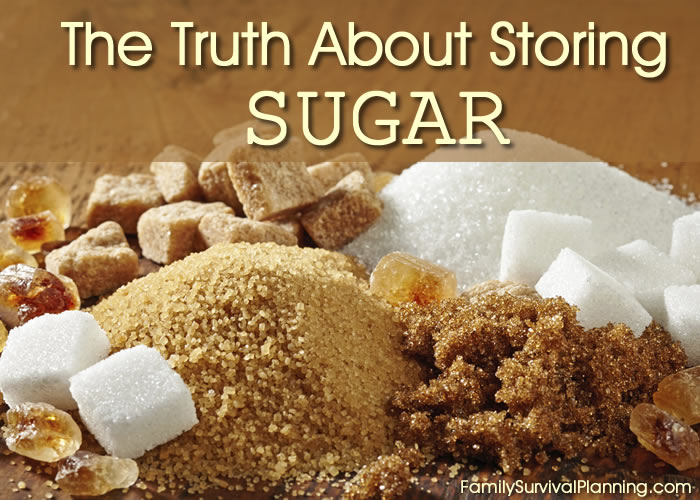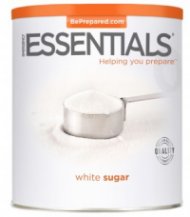- HOME
- Food Storage Basics
- Storing Sugar
The Truth About Storing Sugar

How to store sugar is a topic I've been asked about many times and has been discussed on many websites with varying instructions. Sugar is one of the easiest storage items to store — so let's talk about the truth about storing sugar.
Since there are several forms of sugar, all different in texture, color, and usage, I'll cover how to store sugar by the different types.
Whether sugar is good for us or not, is topic for another time, but for food storage purposes, it is an essential ingredient in many recipes and we all seem to love sweets, don't we? However, using it sparingly for treats in a time of stress or crisis, can be a comfort to children as well as adults — just because it can make difficult times "seem" more normal.
Invest in emergency food storage now and enjoy peace of mind for the next 25 years. Don't miss out on the savings!
The Basics
The basics are: most sugars will store indefinitely as long as they are stored in a cool, dark, dry area and kept free of bugs. It does not deteriorate, but it can get hard or clumpy. It is one of those wonderful storage items that you can buy in bulk or smaller containers, dump it into a food grade bucket and forget about it until needed.
There is only one precaution: Never use oxygen absorbers when storing any type of sugar — that includes honey (which will also last indefinitely). Strangely, oxygen absorbers, when put into a storage container with sugar, will cause the sugar to have a kind of chemical taste and turn the sugar to a solid brick.
White Sugar (granulated)
White sugar - The best way to store it is in 6-gallon plastic buckets with or without a Mylar bag lining. You can also purchase it already hermetically sealed in #10 cans or 6 gallon buckets.
When you need to use the sugar, it may be clumped a bit. White sugar breaks up easily and clumps don't mean there's anything wrong with the sugar. It just means a little moisture was inside when it was sealed. I have heard that if you live in a humid climate, a little rice thrown into the sugar before storing will help absorb moisture and prevent clumping. I live in a very dry climate so have not tried using rice in sugar. Using a desiccant packet will also help. (A desiccant packet is not the same as an oxygen absorber; a desiccant packet absorbs moisture and an oxygen absorbs oxygen.)
Powdered Sugar (confectioner's sugar)

Powdered sugar is just as easy to store as granulated white sugar. It will not clump as much (if at all) because it is a drier sugar to start with. As always, however, make sure to keep it dry and airtight.
I don't use as much powdered sugar as granulated sugar so I just store it in the packaging that it comes in from the grocery store. It can be put into 6 gallon buckets (in the original bags) or poured into #10 cans or canning bottles and sealed (without oxygen absorbers).
Brown Sugar
Brown sugar is a different story — only because it is moist and will dry into a solid block in long term storage depending on how it is stored.
Brown sugar in a #10 can from a preparedness store states it has a 20-year shelf life. How can they claim that when most claim it only lasts six months? Because the double-enameled #10 cans are hermetically sealed, it will keep its fresh flavor and remain isolated from harmful elements, chemicals, and pests. They do not state, however, that it will still be soft in 20 years.
If it's hard at any time that you open it, it can still be used, but it will need to be softened (see below).
Make your own brown sugar — as needed.
Another suggestion would be to make your own brown sugar as needed. Brown sugar is just white granulated sugar with molasses added.
Try this recipe:
- 1/2 lb. sugar
- 1.5 oz molasses
Blend it in a blender or food processor. The amount of molasses added determines whether it becomes light brown or dark brown sugar. You won't believe how much better it tastes than store bought!
Store in an airtight container for about 3 weeks.
How to soften hardened brown sugar.
- Place the brown sugar in an airtight container with a piece of fresh bread placed on top. Seal and leave overnight. If it's not soft and fresh by morning, let it sit another day or two.
- Sprinkle it with a few drops of water, place in a plastic bag, seal, and let sit for a couple days.
- Place it in an open container and put a wet cloth or paper towel over the container. Let sit overnight.
- Put a few apple slices in the container with the sugar and leave closed for a day or two. Remove apple slices once sugar is soft again.
- Use foil or plastic wrap to cover the top of the sugar. Then set a dampened sheet of paper towel (not dripping wet) on top of the foil. Place in an airtight container and seal. Let sit overnight or a few days as needed. Remove foil and paper towel once the towel is dry and sugar is fresh again.
- Buy a clay disc or if you have a pottery piece from a broken clay pot, etc., set it in water for about 30 minutes. Dry the piece so it isn’t dripping wet. Put the clay piece in a container with the sugar and seal. Check after a few days. Keep the piece in with your sugar for months if you’d like–will keep it soft.
Need the sugar soft now?
- Put the brown sugar in a container and place in the microwave with a small bowl full of water beside it. Microwave for about 1 minute–check. If it’s still hard, try for another 30 seconds. You can keep doing this until the sugar is soft, but watch that you don’t melt the sugar. (Microwaving is only a temporary solution - the sugar will harden again unless you use one of the suggestions below.)
- Place the hardened sugar in a baking pan and set in oven (temperature at about 250° F). Check after 5 minutes. If still not soft, continue checking every few minutes until it’s soft and ready to use.
- Place the brown sugar chunk in a microwave-safe container with a lid. Take a square of paper towel and moisten with water (not dripping wet–wring out excess). Place the wet paper towel in the container with the sugar and seal. Place in the microwave for approximately 20 seconds. If still not soft, microwave for a few seconds more, repeating until the sugar is ready to use. Be careful not to melt the sugar.
- Stick chunks of the brown sugar in a food processor or blender and chop/pulse until useable.
Keeping brown sugar soft to use on a daily basis:
- Make sure to store brown sugar in a sealed, airtight container. A clay disc kept in the container can keep it soft for months (see tip above for clay disc). A small piece of bread works also.
- Brown sugar can also be stored in the freezer and thawed a few hours before using.
- In many of the cooking catalogues or stores, there are small brown sugar teddy bears which, when soaked for 15 minutes in water, can be placed in your brown sugar in a closed container. The moisture from the teddy bear keeps the sugar soft. Refresh in water maybe once or twice a year.

















